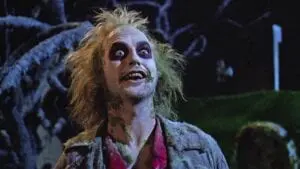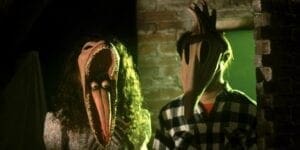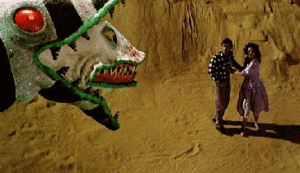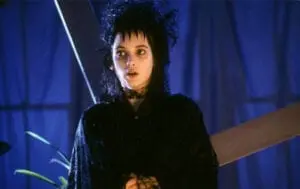Beetlejuice
"The name in laughter from the hereafter."
(1988)
starring Alec Baldwin, Geena Davis and Michael Keaton
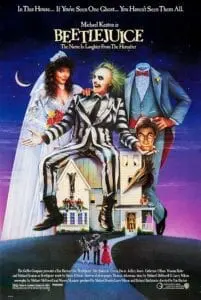
PODCAST:
'80s Movies: A Guide to What's Wrong with Your Parents -
Suicide is Funny???
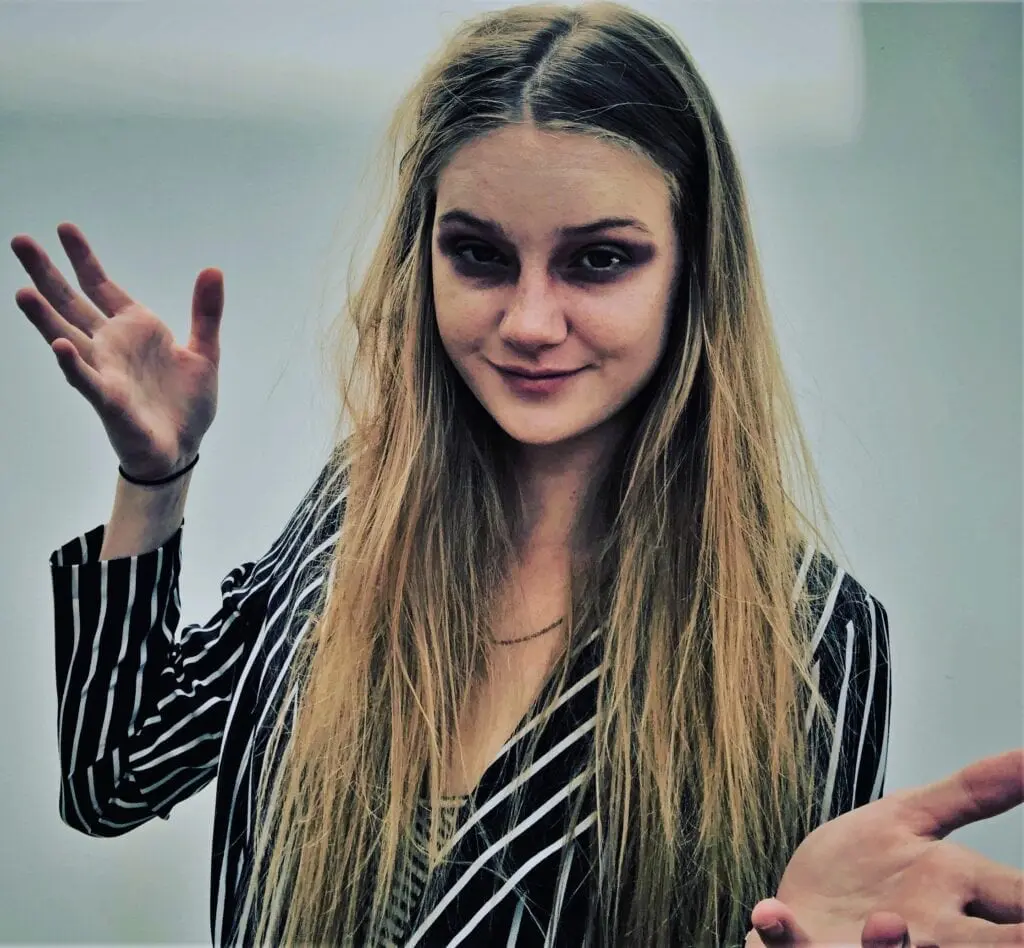
Why it’s rad:
- Introduces the Tim Burton we have all come to know: the director of off-the-wall macabre films.
- Meet Winona Ryder!
- Michael Keaton in his most memorable and unexpected performance.
- Sarcastic demon Betelgeuse is a character that lasts through the ages.
- Epic Day-O dance of the consciously possessed
- Considered one of the best horror-comedies ever made.
- AFI lists it as one of the Top 100 comedies of all time
So '80s:

- Lydia is a goth -- and goths started in the '80s.
- Delia Deetz is the epitome of '80s New York art culture. The severe hair, the self-importance, the ridiculous art, the pretentious friends, and of course, the drug use: so '80s.
- The avant garde renovation for the Maitland home was '80s modern architecture on steroids - more eye-popping than practical. A wall of glass cubes in the sculpture room, the mood colors, and the black and white color schemes with a wavy bright red bar. And, how about that statement wall on an exterior deck? Architectural Digest admits its still impressed.
- Barbara's Breyer horses - every little girl in the '70s and '80s had a Breyer horse collection.
- The fashion. When we think '80s fashion, we think over-the-top - such as Delia's big shoulder pads, all black/white/red colors, or glove headband. But, Barbara and Jane's tiny floral prairie look was equally in. As was Barbara's perm.
Historical Perspective
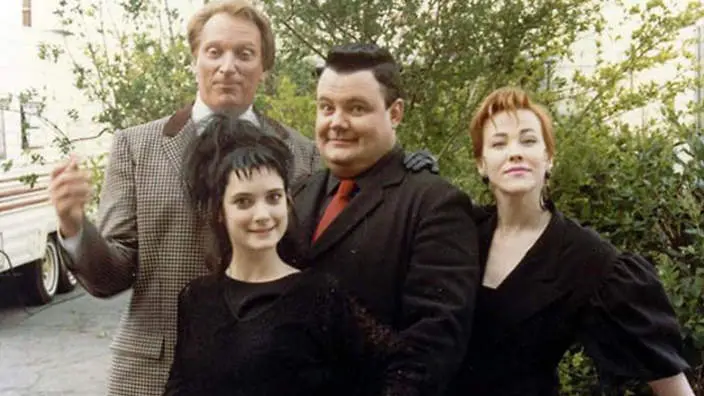
Two working parents and a stepparent. Once the previously taboo divorce became acceptable, the divorce rate skyrocketed. Families that were splitting up was new, and parents turning around and marrying someone else (well, it's all they knew how to do) was happening just as fast. Of course, divorce was put into motion because of women's lib and the return of the woman to the workplace. Larry Wilson told Film Courage, “It’s really a family story about a girl who needs a mom and a dad because her real mom and dad don’t understand her and don’t spend enough time with her so she ends up with two ghosts.”
What’s your damage?
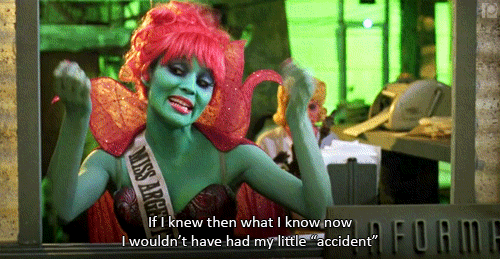
Suicide is funny. The message may be that suicide is pointless: those who offed themselves are designated to be civil spirits for all of eternity - the joke is that it's a fate worse than death. However, Lydia is depressed and suicidal. She writes a suicide note which is played for comedic effect. When her parents encourage her that she can turn one of the spaces into a dark room she says "my life is a dark room" and she is dismissed as being overly dramatic. Additionally, Otho chastises a dinner party guest that her suicide attempt was "dreary."
Beetlejuice is a perv. The first time he meets Barbara, he is all over her; she's slapping him away. The only way to distract him is to put a whorehouse in the model town. And, he's all kinds of inappropriate with teenage Lydia, including forcing her to be his child bride. This movie is rated PG. Lots of little kids saw it in the theater, on HBO, and forever after. It's considered a family film.
The F-bomb. Again, it's PG and yes, PG-13 had been in existence for a few years.
Not one person of color in this film. Other than the Asian party guest, the film is devoid of any actors of color.
The interior decorator is, of course, a gay man. It was tough to get a gay character in a movie in the ‘80s – there was actually a studio belief that audiences didn’t want to see gay main characters. The cliché role of the gay interior decorator, though, was one of the few acceptable exceptions. (See Jules' interior decorator friend Ron in St. Elmo's Fire, department store window dresser Hollywood Montrose in Mannequin and art gallerist Serge in Beverly Hills Cop.)
Behind the Scenes
HOW IT CAME TO BE
It all started with a budding development executive taking notice of a script that needed work. Larry Wilson, then a director of development for director Walter Hill, worked with the writer Michael McDowell to improve the script.
Universal passed. In a big way. Wilson says he’d forged a solid relationship with an exec over Universal who agreed to look it over. “I gave him Beetlejuice to read, and I gave it to him on a Friday, and on Monday his assistant called me and said well, he wants to meet with you. My initial reaction was wow! He'd read it. He must have loved it or he wouldn't have wanted to see me so soon,” Wilson told Den of Geek. “But I went into his office, and he literally said 'what are you doing with your career? This piece of weirdness, this is what you're going to go out into the world with? You're developing into a very good executive. You've got great taste in material. Why are you going to squander all that for this piece of shit', was basically what he was saying.”
David Geffen got a hold of the script and loved it. Geffen Pictures, a fairly new outfit, made a deal with Michael McDowell and Larry Wilson (who was now doubling as a producer and writer), and attached Tim Burton quickly. However, Wilson said he and McDowell were assigned an executive for about a year who had them doing constant rewrites. Wilson said, “Michael and I felt by the end of that process that we'd ruined the script. It was very demoralising.” In his book Burton on Burton, Tim Burton writes that the writing duo “got beaten down by the constant questioning', and that script meetings 'lasted for 24 hours over two days'.
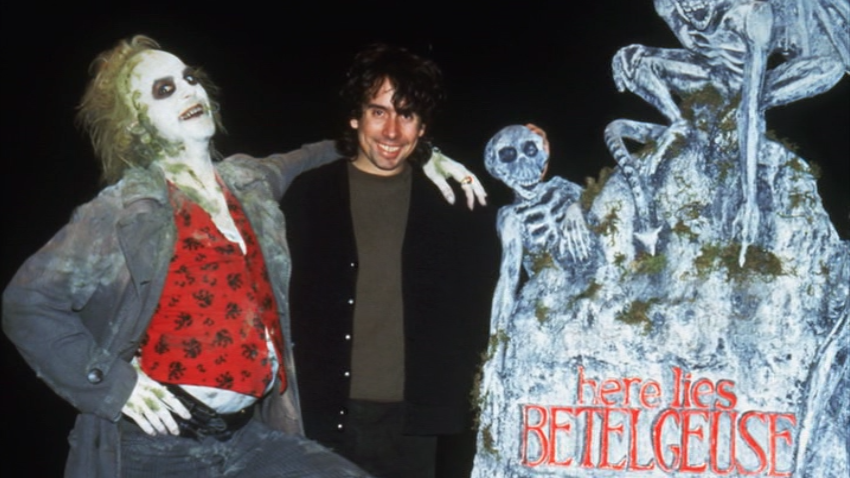
TIM BURTON
Pee Wee’s Big Adventure begat Beetlejuice. Tim Burton was an animation director who had one feature film on his resume. Pee Wee's Big Adventure was a movie based on an absurd children's Saturday morning TV series. It was a surprise hit – enough to get Burton noticed by film studios. He was flooded with scripts and offers, but Burton turned them down. He wasn’t feeling it. But then, he got Beetlejuice.
Pee-Wee and Beetlegeuse share a common trait. Tim Burton said it was both character’s belief in themselves that made him say yes to both. “I believed Pee-wee,” he told Rolling Stone. “So I thought, ‘Let’s just go through the movie and believe him, whatever he does.’ I love extreme characters who totally believe themselves. That’s why I had fun with Betelgeuse.”
Tim Burton loved that the script was a mess. The noob director chose this script because it was so un-Spielbergian, the “It” boy director of the ‘80s. He told Rolling Stone at the time of the film’s release, “The things that interest me the most are the things that potentially won’t work. On Beetlejuice, I could tell every day what was gonna work and what wasn’t. And that was very invigorating. Especially when you’re doing something this extreme. A lot of people have ragged on the story of Beetlejuice, but when I read it, I thought, ‘Wow! This is sort of interesting. It’s very random. It doesn’t follow what I would consider the Spielberg story structure.’ I guess I have to watch it more, because I’m intrigued by things that are perverse. Like, I was intrigued that there was no story.”
Burton finally hired a script doctor whose hobby was studying the afterlife. Warren Skaaren, well known to fix scripts including Top Gun and Romancing the Stone, had a new age, guru-esque outlook on life. He and Burton had two entire nights of talking about death and what becomes of us after we pass. He was known to hand out the book, “Denial of Death.” He based his title demon on the Native American tricksters.

CASTING
It took 20 weeks to cast Betelguese. “When I got the script I was taken aback because it was very strange and it was hard to imagine and visualize how this would eventually play out,” said director of photography Tom Ackerman to Uproxx. “It was an exciting prospect, at the same time daunting.”
Every actor in Hollywood passed. Everyone. “Nearly everyone who is in the movie, at first, said no,” said casting director Jane Jenkins in The Making of Beetlejuice documentary.
Sammy Davis Jr. was the first choice to play Beetlegeuse. Tim Burton envisioned the former Rat Packer in the role, whom he loved when he was a child (Davis Jr. had a No. 1 hit “The Candy Man” in 1972). However, by 1987, the singer was 63. David Geffen had another idea: Michael Keaton, who was best known for Night Shift (1982) and Mr. Mom (1983).
Michael Keaton turned down the role -- twice. Keaton told Charlie Rose that he didn’t get the character of what Tim Burton was trying to do – and that maybe why Burton got so many refusals. Keaton said: X
Beetlejuice is the world’s introduction to Winona Ryder. The young teen had made a splash as the co-lead opposite Rob Lowe in the indie Square Dance, but few people saw that movie. She also had a minor role in another beloved indie, Lucas. Ryder hadn't broken into the mainstream yet. However, everyone noticed her as a goth teen in Beetlejuice. From this, she was cast in Heathers (1989).
Angelica Huston was the original Delia Deetz. The actress’ severe bangs, sharp bob, and nose that in itself is a work of art, gives her the look of a sculptor on the New York modernist art scene. However, Huston became too ill to take the role and had to step down.
Depression led Catherine O’Hara to audition for the part of Delia Deetz. In an interview with The New York Times, O’Hara said David Geffen, whom she hadn’t heard of at that time, hounded her relentlessly to try out for the part, and she repeatedly declined. But finally, she found her schedule empty, and that bummed her out, She decided to audition. It didn’t go well.
Catherine O'Hara's audition was a disaster. “I flew to L.A. from Toronto, and I rented a car. The address was in Burbank. I drove for hours. I thought, What kind of director is this far from show business? I was so late. I got lost. There was no cell phone. I had to pull over somewhere and find a phone booth and phone my agent. I finally, two hours late, got back to Burbank. There was a note on the door from Tim Burton. It said, “I’m sorry. I waited as long as I could," O'Hara told The New Yorker. "I go back home to Toronto. A few weeks later they offer me the part. It’s a good trick. If you’re bad at auditioning, just don’t go.”
Even then, Catherine O’Hara refused the role of Delia Deetz a few times. With Huston out, Tim Burton wanted the SCTV comedienne. He flew out to meet her and convinced her to say yes.
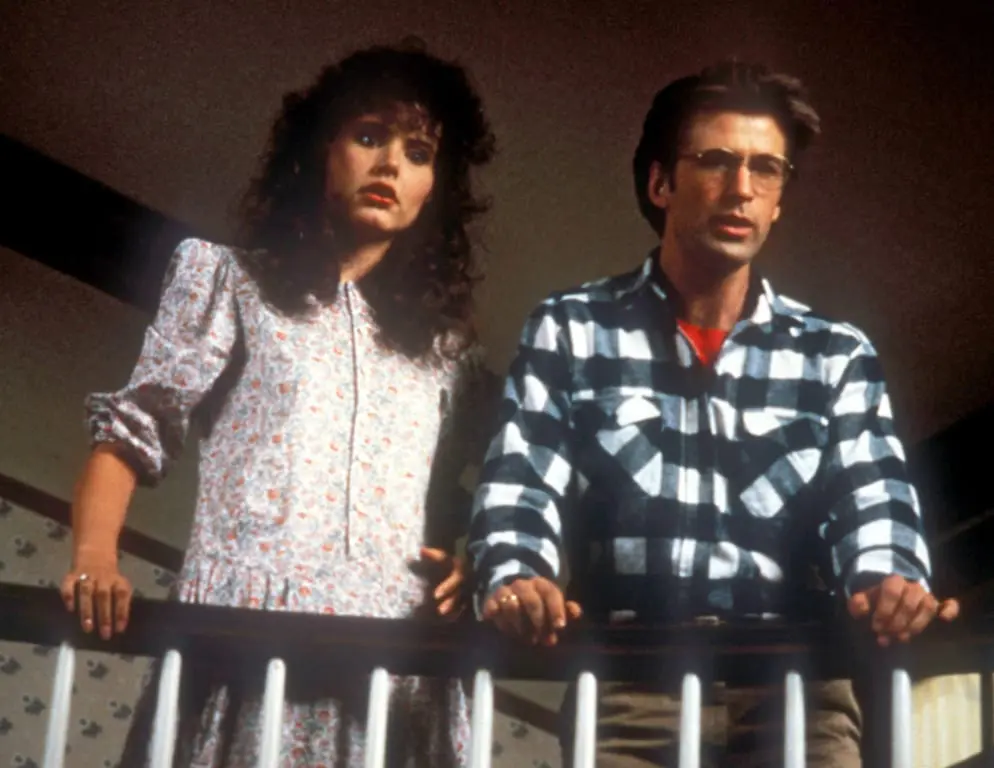
UNDER CONSIDERATION
Other Betelgeuses. Michael Keaton’s take on the obnoxious zombie is a complete original, but it’s not hard to see other actors of the era in the role. Robin Williams was on the top of Burton’s wish list. He offered the role to Arnold Schwarzenegger (who turned it down because he was committed to The Running Man. Other considerations were Sammy Davis, Jr., Dudley Moore, and Sam Kinison (whose agent never relayed the interest to the comic).
Other Lydias. The role of Lydia was highly sought after. Young actresses considered for the part include Brooke Shields, Diane Lane, Sarah Jessica Parker, Jennifer Connolly, Justine Bateman, Heather Langenkamp, Lori Loughlin, and ‘80s teen queen Molly Ringwald. It reportedly came down to Ryder or Alyssa Milano. Ryder’s performance in Lucas won over Burton.
Other directors. Wes Craven was reportedly offered to direct before Burton.
Other Barbaras. Goldie Hawn, Sigourney Weaver, Linda Hamilton, Linda Blair, and Laura Dern were considered for Barbara, but the top choice was Kirstie Alley. However, her contract with "Cheers" prevented her from taking the job.
Other others: Bill Pullman was in the running for Adam. John Candy was considered for Otho.
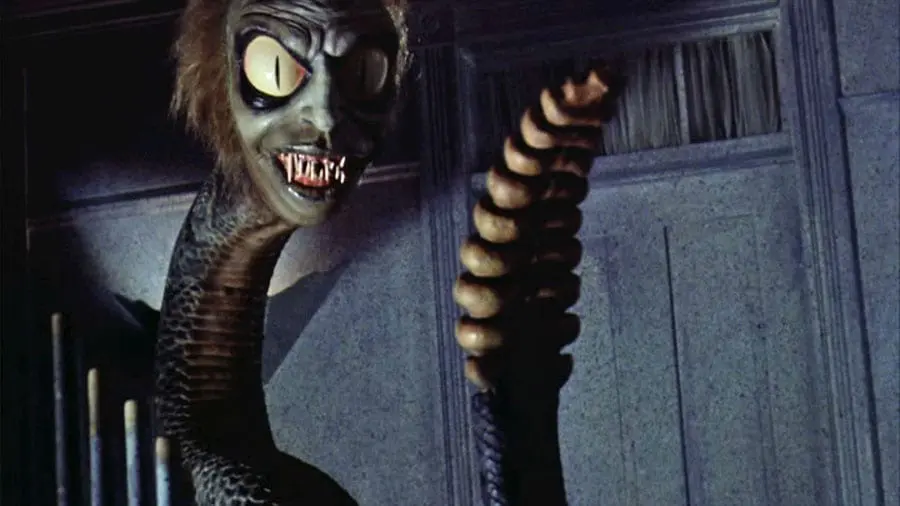
THE CREATION OF BETELGEUSE
Betelgeuse was written as a Middle-Eastern man. As written, his appearance would declare he “was not to be trusted.” The script’s description says: “He is small and wiry, dark, with vaguely Middle-Eastern features. Here, and whenever we see him again at the beginning of a scene, his eyes are COLD and YELLOW and SHAPED LIKE A SNAKE'S -- but after a moment, they melt, becoming human, and liquid, and brown.”
Betelgeuse was envisioned as “Groucho Marx from hell.” Writer Larry Wilson told Yahoo, “Groucho Marx was the fastest, wittiest, most sardonic, absurdist person in the room always. But, it didn’t make any difference because Michael Keaton is Betelgeuse.”
Michael Keaton had an epiphany about how to play Betelgeuse. “The attitude is ‘You write your own reality, you write your own ticket. There are no bars, I can do anything I want and under any rationality I want,'” Keaton said to Rolling Stone in 1988. “At some point,” he says, “you show up on the set and just go f--kin’ nuts. It was rave acting. You rage for 12 or 14 hours; then you go home tired and beat and exhausted. It was pretty damned cathartic. It was rave and purge acting.”
Improv took them to new places. With frenetic Keaton and Second City improv pro O’Hara, Tim Burton wisely let them riff off the script – and it worked. “The thing I love about Michael is that he gets into it,” said the director. “He’d say some funny thing that wasn’t in the script, and we’d get ideas from that. I enjoyed working that way. My animation background — you sit around with a bunch of guys and talk about what would be a good idea to do. The whole cast was like that. It was this hallucination we were all involved in. We knew what we were doing, but we didn’t know what we were doing.”

PRODUCTION
Tim Burton drew the storyboards. It’s surprising that a director would hand draw all the storyboards himself. In this case, Burton was a newer director who was primarily an animator. It made a huge difference in the final look of the product. Art director Tom Ackerman told Uproxx: "The storyboards — which were meticulously drawn, many by him, if not all by him — conveyed a great, almost palpable sense of what he was going for. Did they dictate continuity? We could go to this angle, this angle and that angle. No, they didn’t. But they were stylistically vivid and extremely helpful. When we were preparing Beetlejuice, we had a lot of talks about how the film was going to look. Because obviously the task was to create an afterlife.”
They actually found their postcard village on a postcard. Production designer Bo Welch told Uproxx: “Early on we barely knew each other and Tim, myself, and Richard Hashimoto, the line producer, went location scouting in Vermont to look for the exteriors. This is in the pre-digital era so you don’t Google “cute little towns in Vermont” and be bombarded with a thousand images. So, we just drove aimlessly from one end of Vermont to the other. Eventually we went into a couple of bookstores or gas stations and kept seeing this postcard over and over for this little town called East Corinth, Vt. We saw it enough times where we thought, “Well, that one looks great.” These pictures are exactly what we’re looking for. So, by looking at postcards in gas stations and stores we actually found our location after driving all over Vermont.” Art director Tim Duffield has a similar, but different, memory. “The way we found it as I recall, Tim found it on a laminated placemat in a restaurant or store we were in and he said, 'This is the town right here.'"
The had to build the bridge. It wasn’t easy. To destroy a bridge in a quaint, quiet Vermont town, the crew had to build a bridge first -- one that would collapse perfectly when the director said "roll 'em." Production director Bo Welch said, “Physically, the hardest [project] was the bridge. We kept having thunderstorms. We had to build a big dam, and a thunderstorm would come by and blow it all away."
The afterlife processing center is based on Frank Lloyd Wright architecture. Art director Tim Duffield told Uproxx the set was really cool. "Bo Welch came up with the concept of the Johnson Wax building in Oklahoma designed by Frank Lloyd Wright, with these posts that were spread out at the top; that was our anchor for that [set]. Then we just kind of made it curve around to fake an unlimited perspective on this soundstage that was only 50-75 feet wide," he said. "Ron Strength of Warner painted a big backing of the perspective of the columns getting smaller. We built all the foreground stuff, and all the papers and stuff to make it look like a chaotic Johnson’s Wax building."
Winona Ryder's goth clothes were authentic. The actress wore her own clothes.
SCRIPT CHANGES: WHAT ALMOST WAS
Charles Deetz was a famous novelist who churns novels out by the month. He was changed into a real estate developer who had a nervous breakdown, according to Jeffrey Jones.
Lydia originally had a sister. "Cathy” was Delia and Charles’ daughter together and a sweet teen, much more like the Maitlands, and stood as a contrast to Lydia. Cathy was the daughter the Maitlands connect with and Lydia – who hangs out with “death rockers” -- can’t see them. Script doctor Warren Skaaren made the change, melding Lydia and Cathy into one character. Producer and writer Larry Wilson told Yahoo News, “"Warren got rid of the sister. And what a good decision because then it all became about Lydia. That’s the [change] I remember most vividly, [I remember] going, 'That's right.'"
The Maitlands were older. The second draft of the script includes the description that the Maitlands are further down life’s path. Adam is described as being in his early ‘40s and Barbara has “a wholesome beauty that is mellowing well as she approaches middle age.”
Delia had a drug habit. In the original script, Mrs. Deetz orders her 9-year old daughter Cathy to “be a perfect darling and go get mommy some drugs.” When Cathy asks what kind, her mother responds, “It doesn't matter. Just remember though, too many is better than too few.” Another scene has Otho party prepping by spreading out a “pharmacopeia of legal and illegal substances on Delia's dressing table, and is allowing her to sort through” – then he gives advice on which pills to take when for the perfect high. That jives with Delia unable to wake up when the ghosts try to scare here because, as Lydia says, she’s “sleeping with Prince Valium.”
The Maitlands originally died a grisly death. That car accident seems escapable, no? Deer hunters were tailgating the Maitlands, who were driving extra slow so as not to smash the cake Barbara was bringing as a raffle item at a community picnic. When the dog darts in front of the car, the Maitlands are rear-ended and are initially pushed half off the bridge in which a piling has fallen and has crushed Barbara’s arm. Adam tries to help his wife, tries to escape the car, and tries to drive back onto to bridge, but none of it works. The hunters flee the scene rather than stop to help. We hear the Maitlands screaming before all goes silent.
In an early draft, Betelgeuse’s acts of terror included an IRS audit, forcing Delia into unfashionable clothing, and trying to rape Lydia. Betelgeuse isn’t confined to the house in earlier versions. Once released by the Maitlands, the malevolent demon figures out what is horrifying to each family member. For Charles, he over hears him smugly bragging about how he manipulates his taxes, so the day of the party, Betelgeuse shows up in disguise as an IRS agent who, near party’s end, declares the audit will widen to three weeks. Delia insists on a certain dress be ready for her party, so Betelgeuse becomes an elderly dry cleaner who delivers her dress and fills her closet with polyester blends from Kmart. Cathy gets a rabid squirrel. But, the worst is saved for Lydia, who Betelgeuse preys upon as a goth rocker type who goes by the name of Danny Death. Danny pushes Lydia into her bedroom and begins aggressively kissing and touching her, bursting out of his shirt figuratively and literally: his shirt buttons pop off and then a small deformed version of him erupts from his chest while he leers at Lydia.
Oh, and there was pedophilia. One of Delia’s art friends makes out with Lydia’s 16-year-old best friend, Trixie. It starts with two men lusting over the teen’s “magnificent” and “perfect tits.” Trixie reacts like she’s grossed out by their attention, but by party’s end, she’s making out with a middle-aged man.

ALT TITLES
Scared Sheetless. Beetlejuice didn’t sound like a movie titled that would draw audiences, so Warner Brothers pushed for an alternative title. Burton jokingly suggested Scared Sheetless – and was alarmed that the title was in serious contention for a while.
House Ghost. Right before the release, Warner Brothers execs were nervous. “There were marketing people within Warner Brothers who thought no one would know what 'Beetlejuice' was, but they’d know what a house ghost was,” screenwriter Larry Wilson told Games Radar. “Thank God [they went with Beetlejuice]. I would not like to be here talking about House Ghost the movie."
ALT ENDINGS
Lydia becomes a cheerleader. She fits right into her new school. In this version, the Maitlands live in Adam’s model town that is located in sister Cathy’s bedroom and the two families live harmoniously together.
Lydia dies in a fire and joins the Maitland’s in a ghostly family. One of the rewrites reportedly had suicidal Lydia getting her wish to be with the Maitlands by having her perish, albeit not by her own hand. Writer Larry Wilson told Yahoo News, “A couple of people said to us, 'Do you really think that’s a good idea? Is that really the message you want to be sending to the teenagers of the world? Die in a fire?'"
Charles and Delia Deetz move back to New York but allow Lydia to stay behind in Connecticut in the care of the Maitlands.
The Maitlands shrink to live in a model version of their house in the model town. In this early draft, Beetlejuice is chased by sandworms through the Matiland’s model town for eternity (see below).
Bill the Barber was in the afterlife. After test audiences responded that they loved the Beetlejuice character and wanted to see more of him, Betelguese was “saved” from the sandworms and we see him in the waiting room. Originally, the demon was going to interact with Harry the Barber (the elderly gentleman yammering at Adam during his quick run into town). Instead, his head is shrunken by the Voo Doo warrior.
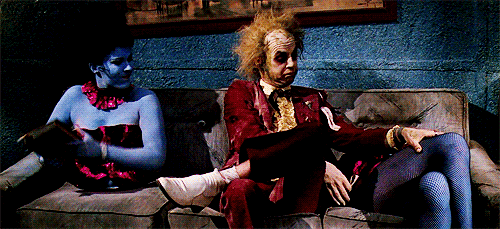
FUN FACTS
Lydia's mom was involved with the Deetz family. In a previous draft script, Lydia's mother is "Evelyn." She’s Charles’ book agent, his ex-wife, and the mother of Lydia. She's at the dinner party and makes more appearances in a previous draft of the script.
Half of Tim Burton’s girlfriend makes a cameo appearance. The legs of the magician’s assistant belonged to Tim Burton’s girlfriend at the time. Her name is never disclosed, but it may have been his future first wife, Lena Gieseke, whom he met in 1988.
Alec Baldwin wanted to affect a snobby accent for Alan. Baldwin told Bloody Disgusting he wanted to play Alan Maitland as a “posh, elegantly spoken man” in the vein of classic film actor Robert Cummings. “Tim is looking down at a piece of paper, and maybe this was the only direction he gave me through the whole movie, he would look up and go, “No. Don’t do that.” And, then he’d go back to drawing.”
The idea was that the living were scarier than the ghosts. Beetlejuice is best remembered for its fast-speaking titular demon, but the conceit of the film was that a sweet ghost couple's house is haunted by living poltergeists. In fact...
The title character is only in 17.5 minutes of the film. Beetlejuice may get the title and all the attention, but this isn't his story. The scene stealing zombie is in less than 1/5 of the 92 minute film.
Lydia's red wedding dress had a point. The color red was used as a nod to an old saying about picking wedding dress colors: "married in red, better off dead."
"Flight 409 arriving at Gate 3." Flight 409 was a tragic United Airlines plane crash that occurred in 1955. The New York to San Francisco flight made crashed into a mountain in Wyoming, claiming all the lives on board.
The fly is a giant puppet. Of course, you couldn’t train a fly to land on certain parts of the model town…so they made a big puppet.
Alec Baldwin thought the film would kill his career – and everyone else. “When we did Beetlejuice, I had no idea what it was about, I thought maybe all of our careers are going to end with the release of this film…. we’re all gonna be dead,” Baldwin told GQ. “But when you’re around Tim [Burton], he was just such a, kind of, a crazy professor. That’s one of the earliest movies I made, and you see everything that’s involved with making movies brought to bear in a movie like that.”
Beetlejuice might have been Burton's living vision board. It might surprise today's audiences to see Jack Skellington make an appearance in Beetlejuice. Burton has been designing the character since 1982 and he inserted in his second film. A Nightmare Before Christmas was released in 1993. Additionally, Batman's wings show up on a Beetlejuice creature transformation - the film came out before Burton was hired to helm a film version of the Caped Crusader.
Beetlejuice launched Netflix. The media platform that changed the way we consume movies and TV began as a mail-order DVD service. The first DVD sent out was Beetlejuice. The year: 1998.
Michael Keaton was an influence on Alec Baldwin's comedic acting. “Keaton knew the secret," Baldwin told GQ. "I would act and then I would have some doubts. I was much more neurotic about what I would do when I was very young, starting out with films. And Keaton just came out – he was like the comedy Annie Oakley. He just was so self-assured. He just tore it up. We were doing a scene where he spits the loogie into his jacket, which he completely improvised. I thought I was gonna choke, I was laughing so hard. Keaton amazed me.”
LEGACY
A kid’s cartoon series was created from the movie. In the animated version, Betelgeuse takes Lydia on adventures through the Neitherworld. It lasted 94 episodes.
A line of action figures. Kids could play with the demon at home. Kenner put out the toys, one in the black and white suit, the other his burgundy tux with the ruffled shirt.
Beetlejuice video games. In 1990, a PC computer game was made for MS-DOS. Based on the animated series, it was titled Adventures of Beetlejuice: Skeletons in the Closet. In 1991, Rare created a Beetlejuice video game for the Nintendo Entertainment System. In 1992, the Nintendo Game Boy got Beetlejuice: Horrific Hijinx from the Neitherworld!, again based on the animated series.
Universal Studios theme parked launched a Beetlejuice-themed stage performance. "Beetlejuice’s Rock and Roll Graveyard Revue" was an attraction that gave tired park goers an opportunity to rest their feet.
Beetlejuice wound up being Michael Keaton's audition for Batman. DC Comics fanboys could not be more appalled when it was announced that Michael Keaton would play Batman. No one could seem him as Bruce Wayne – his typecasting was more of the gum chewing, frenetic, irreverent bordering on disrespectful, loser types. Keaton won over Tim Burton, though, in his original interpretation of the undead con man Betelgeuse. As Burton’s star rose, so did Keaton’s.
Beetlejuice won an Academy Award. For makeup, of course! Makeup artist Ve Nille took home the Oscar (as well as some other awards). Geena Davis also won an Academy Award that year – for The Accidental Tourist.
Beetlejuice swept the Saturn Awards. It won Best Horror film over Child’s Play and films in the Halloween and Friday the 13th franchises. Sylvia Sidney (case worker "Juno”) won a Saturn award for best actress.
AFI named Beetlejuice one of the Top 100 Funniest American Movies. It's No. 88, between Fast Times at Ridgemont High (1982) and The Jerk (1979).
It's now a Broadway musical. In April 2019, original music was added to the script and the ghost with the most took the stage at New York’s Winter Garden. The Guardian gives it 3 out of 5 stars, stating, “Beetlejuice is probably everything that’s wrong with Broadway: the privileging of style over substance, the nonsensical structure, the songs that seem to fall right out of your ears. But why not sit forward, tense up and just enjoy the undead fireworks. And the sandworm.”
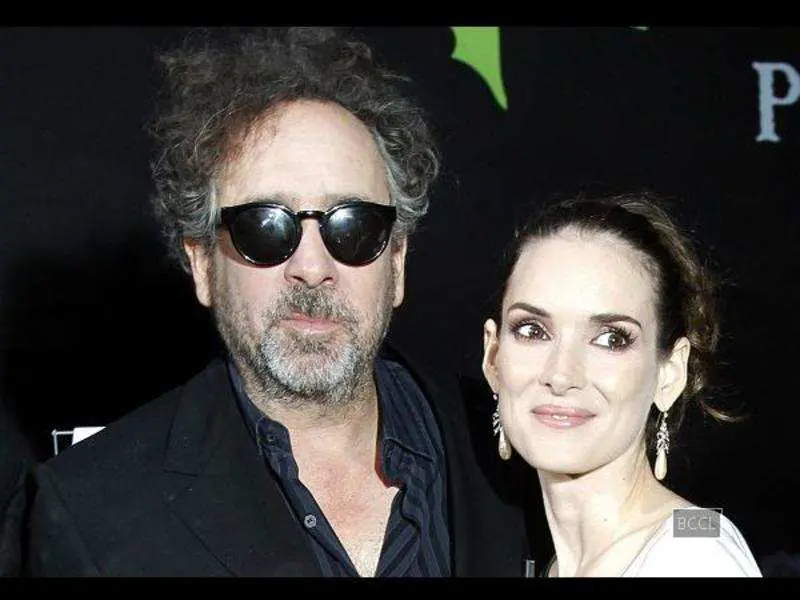
SEQUEL
Beetlejuice 2? There’s been talk of a sequel for decades. With the success of the first film, there was pressure on Tim Burton to make a sequel.
Beetlejuice Goes to Hawaii. Tim Burton has implied that to get the studio off his back, he told them he was working on a sequel, and gave them the ridiculously titled Beetlejuice Goes to Hawaii. In it, Beetleguese changes into a demon named Juicifer who creates mischief on the island. It seems he went through the motions enough to make the studio believe he was working on it. However, Burton's career was skyrocketing and was able to pivot to direct Batman and Batman Returns.
In 2011, plans were resurrected to make the sequel with Seth Grahame Smith scripting. Once again, though, it was announced but seemed to disappear through the years.
And yet...Warner Bros. is apparently still developing the sequel. Michael Keaton and Tim Burton reteaming for Dumbo relit a fire about a Beetlejuice sequels. Keaton has enthusiastically and vocally supported the notion. Winona Ryder has said she'd sign on. And, Tim Burton wants to do it if the script is right. Screenwriter Mike Vukadinovich was brought on in 2017.
Larry Wilson envisioned a follow-up film that would feature a one-sided infatuation. "It would have been a continuation of the story. Mr. Deetz would have developed a crush on Geena Davis' character. That would have been my idea. It would have been driven by character and not driven by a premise,” Wilson told Yahoo! “I’ve always been worried about what a Beetlejuice sequel would be because of ideas like Beetlejuice goes Hawaiian.
Soundtrack
Tim Burton gave Danny Elfman his first shot at scoring films when he hired him for Pee-Wee's Big Adventure (1985). The Oingo Boingo front man continued to build a resume scoring comedies in the years that followed. When Burton selected his follow-up to Pee Wee, he reteamed with Elfman - what would become a lifetime of collaborations. Elfman composed the Beetlejuice score, punctuating it with two established Harry Belafonte songs. Originally, a song by the Ink Spots was selected for the dinner party dance possession, but Catherine O'Hara and Jeffrey Jones suggested "Day-O (The Banana Boat Song)." For Lydia's closing dance, it made sense to Elfman to bookend the film with another Belafonte Calypso number with "Jump in Line (Shake, Shake, Senora)"
Director: Tim Burton
Screenwriter: Michael McDowell, Larry Wilson
Release date: March 30, 1988
Rating: PG
Opening Weekend Rank: #1. Other new releases were Bright Lights, Big City (#3) and The Seventh Sign (#5)
Opening Weekend Box Office: $8 million
Lifetime Gross: $74 million (inc. 2018 rerelease)
Budget: $15 million
Production Company: The Geffen Co.
Distributor: Warner Bros.

